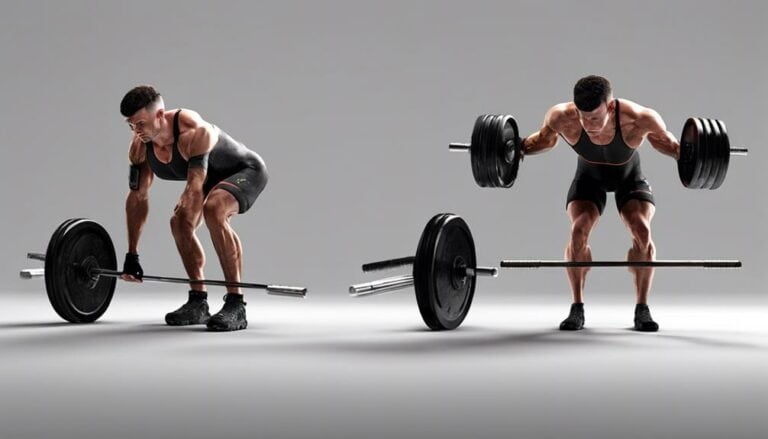When it comes to finding the equilibrium between strength and agility training for Enduro racing, you may want to contemplate a strategic approach.
It's not just about hitting the gym; it's about honing in on the specific muscle groups that will propel you towards success on the trails.
As you navigate the intricate dance between power and nimbleness, a thoughtful blend of exercises and targeted workouts can be the key to unleashing your full potential in the domain of Enduro racing.
Key Takeaways
- Achieve balance by combining strength training for muscle endurance with agility training for reflexes and coordination.
- Adjust training frequency and volume based on weaknesses to optimize performance.
- Incorporate plyometric exercises, compound movements, and agility drills for a well-rounded training regimen.
- Monitor progress, analyze performance metrics, and adjust training plans regularly for continuous improvement.
Importance of Strength and Agility Balance
Achieving a harmonious blend of strength and agility is a fundamental cornerstone for mastering the physical challenges inherent in enduro racing.
In enduro racing, your body undergoes intense and prolonged stress, requiring a unique combination of power and nimbleness.
Strength training forms the foundation for your physical preparedness, enhancing your muscle strength and endurance to tackle long and arduous tracks.
On the other hand, agility training sharpens your reflexes and coordination, enabling you to navigate tight corners and obstacles with finesse.
Training Frequency and Volume
To optimize your training regimen for enduro racing, the key consideration lies in determining the ideal frequency and volume of your strength and agility sessions.
For enduro enthusiasts, aiming for 2-3 strength training sessions per week is recommended to strike a balance between building strength and agility. Adjust your training frequency based on your specific needs, focusing on improving any areas of weakness you may have identified.
Increasing your training volume to 3 sessions per week can help enhance muscular balance and overall performance. However, it's critical to scale back to 2 sessions as you start seeing improvements to prevent overtraining and allow for adequate recovery.
Keeping each session around an hour long is beneficial as it complements your riding routine while maximizing gains in both strength and agility.
Exercises for Strength and Agility
Incorporate plyometric exercises like box jumps and agility ladder drills to enhance explosive power and agility for improved performance in enduro racing. These dynamic movements not only build strength but also help you react quickly to the demands of the track.
To further boost your strength, focus on compound movements such as squats, lunges, and deadlifts. These exercises engage multiple muscle groups simultaneously, mimicking the demands of enduro racing.
Don't forget to incorporate balance and stability exercises like single-leg squats and stability ball exercises. These won't only improve your coordination but also enhance your control over challenging terrain.
Additionally, bodyweight exercises like push-ups, pull-ups, and planks are essential for developing upper body strength and endurance, essential for exploring rough trails effectively.
Incorporating Agility Drills
Enhancing your agility for enduro racing involves incorporating a variety of dynamic drills and exercises to improve your coordination and responsiveness on the bike. Agility drills such as ladder drills, cone drills, and agility hurdles can greatly enhance your coordination and responsiveness. These drills focus on quick direction changes, accelerations, and decelerations, mimicking race scenarios and improving your ability to react swiftly.
Additionally, proprioception training using balance boards, stability balls, and bosu balls can help enhance your body control and stability, essential for maneuvering challenging terrains during races.
To further boost your agility, incorporating plyometric exercises like box jumps and depth jumps can help develop explosive power and quick twitch muscle fibers, essential for quick movements on the bike. Finally, integrating trail riding sessions with technical sections can improve your bike handling skills, balance, and adaptability on varied terrains, ultimately enhancing your overall performance in enduro racing.
Monitoring Progress and Adjustments
As you progress in your training regimen for enduro racing, closely monitoring your strength gains and agility improvements will be pivotal for making necessary adjustments to optimize your performance. To make sure you're on the right track, consider implementing the following strategies:
- Monitor progress: Track your strength gains and agility improvements over time to gauge your development accurately.
- Adjust training intensity: Use performance metrics and feedback from coaches to fine-tune the intensity of your training sessions.
- Utilize performance data: Analyze performance data to pinpoint areas where you excel and areas that require more attention.
- Reassess training plans: Regularly review and adjust your training plans to maintain a balanced focus on strength and agility.
- Implement periodization techniques: Apply periodization techniques to structure your training cycles effectively for best performance in enduro racing.
Conclusion
Congratulations! You've successfully balanced strength and agility training for Enduro racing.
Now, just when you thought you'd it all figured out, get ready to face the unpredictable twists and turns of the racecourse. Remember, in the world of Enduro racing, the only constant is change.
Stay adaptable, stay focused, and keep pushing yourself to new limits. The true test of your training awaits on the track. Good luck!

